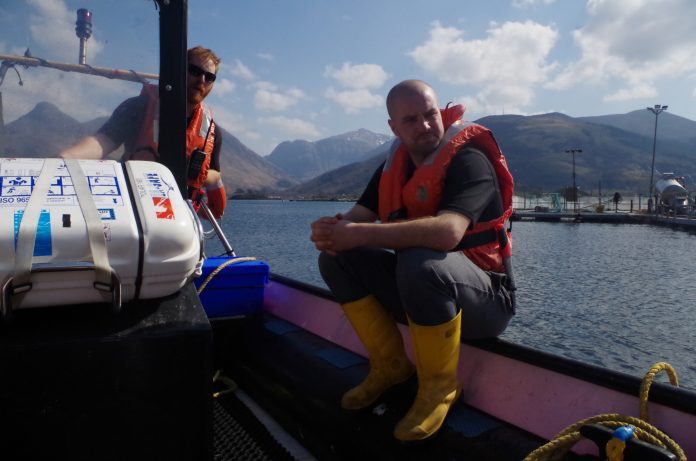Leven Seawater farm is Mowi Scotland’s best performing site. Its five pens were also the first to embrace cleaner fish.
With the news that Mowi bought Ocean Matters’ lumpfish facility in Anglesey, North Wales, last week, SalmonBusiness experienced first hand how the creatures are supporting the salmon farmer to move away from chemical treatments. Mowi also farms wrasse from the Anglesey Aquaculture site (also in North Wales) which it purchased in 2017.
Cleaner fish
“Cleaner fish have been used for here for six years,” explained farm manager Andy Martin who explained that it was the first site to do so. “We used to take in wild-caught wrasse – and they saw massive success in it. We went four and a half years here without using any medicines on salmon – just cleaner fish – we want to get back to that,” he said.

The site at Loch Leven is next to a slightly menacing promontory peppered with the gravestones of long deceased Highland chieftains. It seems a little fitting that large black sheets of plastic dangle over the salmon pens like some creature from the deep. But the reasons for them are quite wholesome.
- Read more: Mowi Scotland acquires lumpfish breeder
“It’s a tough plastic which we put in. It imitates the kelp in the wild and the wrasse and the lumpsuckers will live in it, so it acts like a hide for them,” explained Martin. “We used to have bits of sheets of plastic in the water – as the lumpfish like to stick to stuff and we came up with this to the fake kelp. We are trying to make it look like home.”

Real kelp
Martin told SalmonBusiness that Mowi Scotland will move from plastic to real kelp sourced from a local seaweed farmer. ”We are going to roll it out to all the sites now – and we’ll get all those benefits from that,” he said. “One of the cleaner fish team came down and talked to us about putting real kelp in – attaching it to rope and getting real kelp in. Then we won’t have to lift it out and clean it all the time.”

A lot goes into taking care of the cleaner fish. “The thing is is that if we look after our wrasse as much as we look after our salmon then we don’t have to lift nets all the time, we don’t have to put tarpaulin around our cages or use medicines to get rid of lice. That’s the whole point of having them.”
A sea lice count reveals a few which are then are then counted and categorised. The fish are sedated with MS-222 – which relaxes them and just enough to knock them out for a few moments. Luckily, a lumpfish has also been caught in the count for us to observe up close. “The lumpys take a lot longer to be anesthetised,” smiled assistant manager Lewis Gibson, holding the emerald coloured fish.

Feed
Lumpfish are fed 0.2g pellets and wrasse are given feed balls which they nibble at. Martin explained that wrasse are very successful in warmer temperatures and when it gets colder they seem to want to go deep. “That’s when we introduce the lumpfish which are a lot tougher and they’ll last through the winter until about now, that’s when the wrasse start to get active again,” he said.

“When we start to hit a threshold – you have to take the feed away for three days – so that they look for lice. After that, they get fed again,” explained Gibson. Three days is the maximum that feed is taken away.
Six years later, Martin is convinced that the future is cleaner fish, with the team observing an improvement with lice results. “Now the quality of the farmed wrasse is just phenomenal,” he added.


